
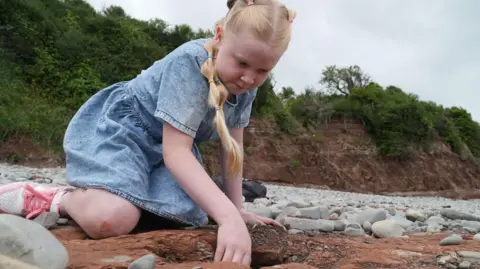 BBC
BBC
"We were just out looking to see what we could find, we didn't think we'd find anything," says Tegan, on the beach where the discovery was made
When 10-year-old Tegan went for a summer holiday beach stroll with her mum, she had no idea they would actually be walking in the footsteps of dinosaurs.
The schoolgirl spotted five enormous footprints that dinosaur experts believe are the mark of a camelotia that was there more than 200 million years ago.
Palaeontologists think the footprints, which are up to 75cm (30in) apart, were made by a huge herbivore from the late triassic period, and now there are efforts to get them verified.
Tegan and mum Claire have been told by the National Museum Wales palaeontology curator that she is "fairly certain they are genuine dinosaur prints".

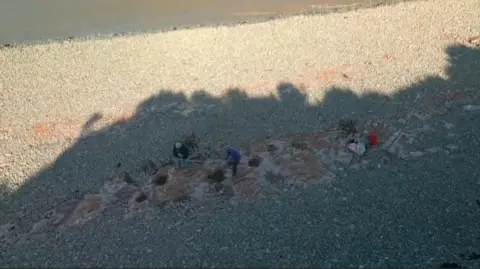 House 7 Creative
House 7 Creative
The aerial shot of the footprints found by Tegan shows experts the possible stride pattern of the dinosaur across this spot more than 200 million years ago
"We've got five footprints and we're talking about half-to-three-quarters of a metre between each one," Cindy Howells told the BBC's Our Lives programme.
"These footprints are so big, it would have to be a type of dinosaur called a sauropodomorpha."
Tegan's monster discovery was on the south Wales coast near where her mum used to live.
"It was so cool and exciting," said Tegan, who had travelled from Pontardawe near Swansea to the Vale of Glamorgan looking for fossils.
"We were just out looking to see what we could find, we didn't think we'd find anything.
"We found these were big holes that looked like dinosaur footprints, so mum took some pictures, emailed the museum and it was from a long-necked dinosaur."
Claire emailed Cindy a few days after the find in the red siltstone at Lavernock Point between Cardiff and Barry on a stretch of the Glamorgan Heritage Coast known to be a prehistoric hotspot.

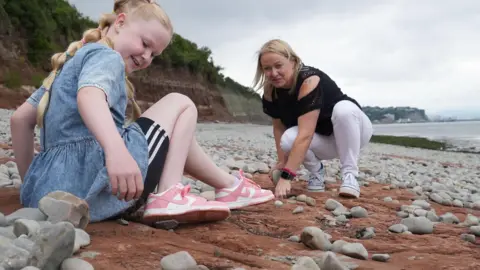
"It was so cool and exciting," says Tegan, with her mum Claire
Cindy, the go-to dinosaur expert of 40 years in this part of the UK, said what convinced her they were genuine was the consistent stride pattern.
"If they were random holes, we'd be wary but because we have a left foot, a right foot and then a left and another right... there's a consistent distance between them," she said.
"It''s quite a significant find - the buzz you get when someone contacts us with a definite dinosaur find, it's amazing."
Claire was chuffed their hunch was right and has invigorated her junior dino hunter daughter.
"It's hard to comprehend you're walking on the same beach that hundreds of millions of years ago some massive prehistoric animal was here," she said.
"You can spent a lifetime looking for dinosaur treasures so for it to happen for Tegan at this age is great."
What is a camelotia dinosaur?
The latest prehistoric find on this stretch of coast is a print from the sauropod family of dinosaurs - including the brachiosaurus and diplodocus, distinctive by their very long necks, long tails, big body and small head.
Cindy believes the footprint is from a camelotia, that lived across parts of Europe.
Little is known about them - compared what experts know about stegosaurus, triceratops and the mighty T-rex - but it is thought they walked on their front feet and their hind limbs, were herbivorous and from the late triassic period.

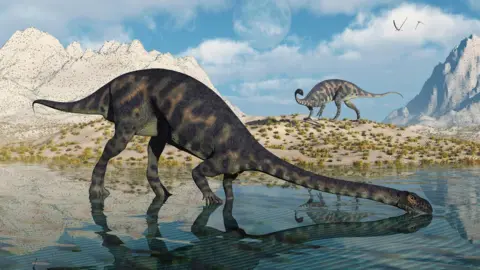 Getty Images
Getty Images
Illustrations of what a camelotia may have looked like are rare, but experts think it closely resembled the massospondylus, shown here
"We think these prints were made by a reasonably large, herbivorous dinosaur, added Cindy.
"While we haven't any bones here, bones of similiar dinosaurs were found on the otherside of the Bristol Channel.
"A camelotia would have stood about 3m (4ft) tall, 4-5m (13-16ft) long and is an early sauropodomorph with a relatively long neck, long tail and walked on two legs but could walk on all four when grazing for food."
Is Wales a dinosaur find hotspot?
Cindy is pretty certain "Tegan's footprints" are linked to the first dinosaur prints found in Wales in 1879 in nearby Porthcawl.
Bones were then unearthed in Cowbridge in the Vale of Glamorgan before more footprints were found at The Bendricks near Barry and Sully - now a site of special scientific and paleontological interest.

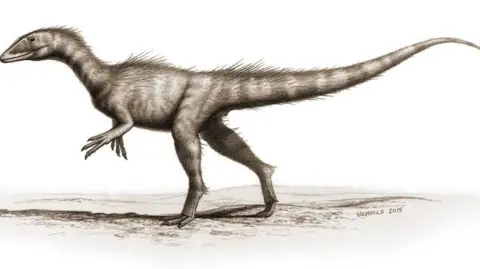 B.NICHOLLS
B.NICHOLLS
The 201-million-year-old dinosaur - dracoraptor hanigani, or "dragon thief" - "that fell out of a cliff face on the beach in 2014 where Tegan's footprints are
A full dinosaur skeleton was unearthed in 2014 on the same beach near Penarth where Tegan found her footprints - although that was a 201-million-year-old dracoraptor and a meat-eating cousin of the T-rex.
Four-year-old Lily found a well-preserved dinosaur footprint at The Bendricks three years ago and now Tegan has spotted some more just down the coast.
"It's amazing as up until recently, we had so few dinosaurs finds in Wales we didn't think we had much in the way of dinosaurs here," said Cindy.

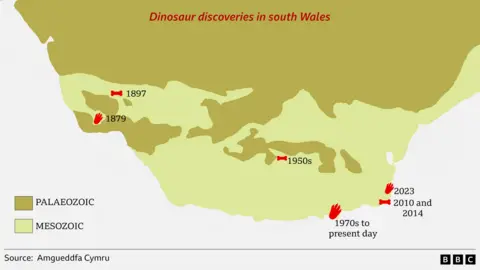 Amgueddfa Cymru
Amgueddfa Cymru
"Now we're getting a footprint or bone find every five to six years and we now know we've a continuous sequence of dinosaurs living in Wales over 15 million years or so - it's amazing.
The south Wales group of the Geologists' Association, of which Cindy is vice-president, believes it is "the best site in Britain for dinosaur tracks, external of the triassic period".
What was Wales like when dinosaurs roamed?
Cindy has said Wales, whose geolological history dates back 700 million years, was a hot desert subject to flash floods when the dinosaur that formed the footprints found by Tegan roamed.
She was keen to quickly analyse the prints as she knew it as a well-known spot for prehistoric finds.
"The rocks around this area are triassic rocks, formed in the deserts and we know we've got dinosaur footprints in them," added Cindy.
"Some 220 million years ago, Wales looked like what the Middle East does now so very hot, dry with deserts, and the sea was hundreds of miles away.

 Amgueddfa Cymru
Amgueddfa Cymru
How palaeontologists think Wales might have looked during the late triassic period
"But sea level started to change and continents breaking apart, it was getting damper, the sea was flooding the deserts and the environment was more favourable for dinosaurs.
"Then 200 million years ago, Wales was like the Mediterranean is now, with shallow, warm tropical seas and little islands."
Cindy has now written a report for other palaeontologists on her view they are from a dinosaur, to verify for the find.
"It's brilliant to say to people we have dinosaur footprints on our coast in south Wales," she added. "You've just got to be in the right place at the right time.
"In museums, we don't have time to go out and do that exploration ourlseves so we rely on people like Tegan doing it for us. We can't do our job without it."

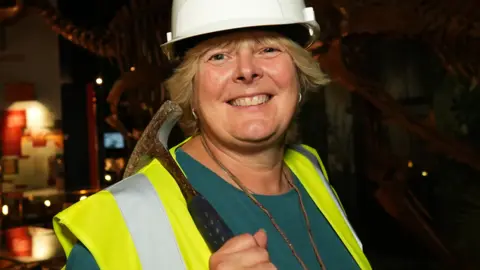 House 7 Creative
House 7 Creative
Cindy Howells has been chronicling the prehistoric history for Wales for 40 years and gets an email a week of possible finds
The Geologists' Association has told amateur dino hunters that footprints can be "difficult to see" as many are covered at high tide.
"It is best to go after high tide when the tracks may retain small puddles of water," the group advises.
"It is also easier to spot the footprints when the sun is low in the sky as longer shadows will help throw the footprints into relief."
- You can watch Our Lives on BBCiPlayer.
 (1).png)
 4 months ago
10
4 months ago
10


















